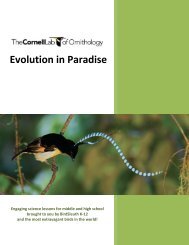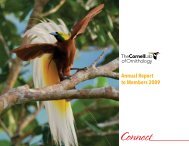National Survey of Fishing, Hunting, and Wildlife ... - All About Birds
National Survey of Fishing, Hunting, and Wildlife ... - All About Birds
National Survey of Fishing, Hunting, and Wildlife ... - All About Birds
Create successful ePaper yourself
Turn your PDF publications into a flip-book with our unique Google optimized e-Paper software.
• Responses are not collected fromall those in the sample or therespondent is unwilling to provideinformation (nonresponse error).• Values are estimated impreciselyfor missing data (imputation error).• Forms may be lost; data maybe incorrectly keyed, coded, orrecoded, etc. (processing error).The Census Bureau employs qualitycontrol procedures throughout theproduction process, including theoverall design <strong>of</strong> surveys, the wording<strong>of</strong> questions, the review <strong>of</strong> the work<strong>of</strong> interviewers <strong>and</strong> coders, <strong>and</strong> thestatistical review <strong>of</strong> reports to minimizethese errors. Two types <strong>of</strong> nonsamplingerror that can be examined to a limitedextent are nonresponse <strong>and</strong> undercoverage.Nonresponse. The effect <strong>of</strong> nonresponsecannot be measured directly, butone indication <strong>of</strong> its potential effect isthe nonresponse rate. For the FHWARscreener interview in the United States,the household-level nonresponse ratewas 29 percent. The person-levelnonresponse rate for the detailedsportsperson interview in the UnitedStates was an additional 31 percent<strong>and</strong> for the wildlife watchers it was33 percent. Since the screener nonresponserate is a household-level rate<strong>and</strong> the detailed interview nonresponserate is a person-level rate, we cannotcombine these rates to derive an overallnonresponse rate. Since it is unlikelythe nonresponding households to theFHWAR have the same number <strong>of</strong>persons as the households successfullyinterviewed, combining these rateswould result in an overestimate <strong>of</strong> the“true” person-level overall nonresponserate for the detailed interviews.Coverage. Overall screener undercoverageis estimated to be about 13percent. Ratio estimation to independentpopulation controls, as describedpreviously, partially corrects for thebias due to survey undercoverage.However, biases exist in the estimatesto the extent that missed persons inmissed households or missed persons ininterviewed households have differentcharacteristics from those <strong>of</strong> interviewedpersons in the same age group.Comparability <strong>of</strong> Data. Data obtainedfrom the 2011 FHWAR <strong>and</strong> othersources are not entirely comparable.This results from differences in interviewertraining <strong>and</strong> experience <strong>and</strong> indiffering survey processes. This is anexample <strong>of</strong> nonsampling variabilitynot reflected in the st<strong>and</strong>ard errors.Therefore, caution should be usedwhen comparing results from differentsources. (See Appendix C.)A Nonsampling Error Warning. Sincethe full extent <strong>of</strong> the nonsampling erroris unknown, one should be particularlycareful when interpreting results basedon small differences between estimates.The Census Bureau recommends thatdata users incorporate informationabout nonsampling errors into theiranalyses, as nonsampling error couldimpact the conclusions drawn fromthe results. Caution should also beused when interpreting results basedon a relatively small number <strong>of</strong> cases.Summary measures (such as medians<strong>and</strong> percentage distributions) probablydo not reveal useful information whencomputed on a subpopulation smallerthan 90,000 for screener data, 100,000for the detailed sportsperson data, <strong>and</strong>235,000 for the wildlife-watchers data.SAMPLING ERRORSince the FHWAR estimates comefrom a sample, they may differ fromfigures from an enumeration <strong>of</strong> theentire population using the same questionnaires,instructions, <strong>and</strong> enumerators.For a given estimator, the differencebetween an estimate based on asample <strong>and</strong> the estimate that wouldresult if the sample were to include theentire population is known as samplingerror. St<strong>and</strong>ard errors, as calculated bymethods described in “St<strong>and</strong>ard Errors<strong>and</strong> Their Use,” are primarily measures<strong>of</strong> the magnitude <strong>of</strong> sampling error.However, they may include some nonsamplingerror.St<strong>and</strong>ard Errors <strong>and</strong> Their Use. Thesample estimate <strong>and</strong> its st<strong>and</strong>ard errorenable one to construct a confidenceinterval. A confidence interval is arange that has a known probability<strong>of</strong> including the average result <strong>of</strong> allpossible samples. For example, if allpossible samples were surveyed underessentially the same general conditions<strong>and</strong> using the same sample design, <strong>and</strong>if an estimate <strong>and</strong> its st<strong>and</strong>ard errorwere calculated from each sample, thenapproximately 95 percent <strong>of</strong> the intervalsfrom 1.96 st<strong>and</strong>ard errors belowthe estimate to 1.96 st<strong>and</strong>ard errorsabove the estimate would include theaverage result <strong>of</strong> all possible samples.A particular confidence interval may ormay not contain the average estimatederived from all possible samples.However, one can say with specifiedconfidence that the interval includesthe average estimate calculated fromall possible samples. St<strong>and</strong>ard errorsmay also be used to perform hypothesistesting, a procedure for distinguishingbetween population parameters usingsample estimates. The most commontype <strong>of</strong> hypothesis is that the populationparameters are different. An examplewould be comparing the proportion <strong>of</strong>anglers to the proportion <strong>of</strong> hunters.Tests may be performed at variouslevels <strong>of</strong> significance. A significancelevel is the probability <strong>of</strong> concludingthat the characteristics are differentwhen, in fact, they are the same. Forexample, to conclude that two characteristicsare different at the 0.05 level <strong>of</strong>significance, the absolute value <strong>of</strong> theestimated difference between characteristicsmust be greater than or equalto 1.96 times the st<strong>and</strong>ard error <strong>of</strong> thedifference. This report uses 95-percentconfidence intervals <strong>and</strong> 0.05 level <strong>of</strong>significance to determine statisticalvalidity. Consult st<strong>and</strong>ard statisticaltextbooks for alternative criteria.Estimating St<strong>and</strong>ard Errors. TheCensus Bureau uses replicationmethods to estimate the st<strong>and</strong>ard errors<strong>of</strong> FHWAR estimates. These methodsprimarily measure the magnitude <strong>of</strong>sampling error. However, they domeasure some effects <strong>of</strong> nonsamplingerror as well. They do not measuresystematic biases in the data associatedwith nonsampling error. Bias isthe average over all possible samples<strong>of</strong> the differences between the sampleestimates <strong>and</strong> the true value.Generalized Variance Parameters.While it is possible to compute <strong>and</strong>present an estimate <strong>of</strong> the st<strong>and</strong>arderror based on the survey data for eachestimate in a report, there are a number<strong>of</strong> reasons why this is not done. Apresentation <strong>of</strong> the individual st<strong>and</strong>arderrors would be <strong>of</strong> limited use, sinceone could not possibly predict all <strong>of</strong>the combinations <strong>of</strong> results that maybe <strong>of</strong> interest to data users. Additionally,data users have access to FHWARmicrodata files, <strong>and</strong> it is impossible toU.S. Fish <strong>and</strong> <strong>Wildlife</strong> Service <strong>and</strong> U.S. Census Bureau 2011 <strong>National</strong> <strong>Survey</strong> <strong>of</strong> <strong>Fishing</strong>, <strong>Hunting</strong>, <strong>and</strong> <strong>Wildlife</strong>-Associated Recreation 123






